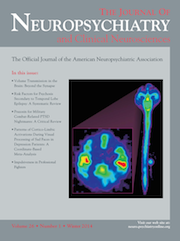Case Report
“Mr. A.” is an 18-year-old White man who was diagnosed with schizophrenia at age 16. Before the onset of his first psychiatric symptoms, he had done very well in school. At age 16, the family began to notice unusual behavior: gradually withdrawing from interactions with family and friends; talking less; staring; refusing to go school; standing up for hours at the bus station.
Mr. A. was diagnosed with schizophrenia and subsequently had trials of various psychotropic medications without significant improvement, partly due to medication nonadherence. When the situation became unmanageable because of A’s escalating aggressive behavior, he required hospitalization at our state facility.
At the beginning of this hospitalization, Mr. A. presented as being selectively mute, staring, posturing, striking out at staff, and not attending to his personal hygiene. A trial of lorazepam (up to 6 mg po/day) and clozapine temporarily improved his aggressive behavior.
An MRI of his brain showed mild-to-moderate diffuse volume loss greater than expected for the patient’s age and progressive when compared with an MRI of the brain done at age 16. Mr. A. was diagnosed with Dementia, NOS. A medication washout and re-evaluation was done. His clinical status severely deteriorated. He was spending most of the time lying in bed in a fixed position, with staring and posturing, and at times showing aggressive behavior.
A consulting neurologist ruled out metachromatic leukodystrophy, systemic lupus erythematosus, Sjogren’s disease, Hashimoto’s thyroiditis, Wilson’s disease, velocardiofacial syndrome, Tay-Sachs disease, Sandhoff disease, HIV, and amino acids defects.
After he was transferred to our ward, Mr. A. was aggressively treated for catatonia. He responded well to a combination of clozapine, a high dose of lorazepam (12–14 mg po and im/day), divalproex, and amantadine. Maximal response was noted after 8 weeks of treatment. Trials of memantine and topiramate were unsuccessful, suppressing his appetite and leading to no greater improvement. Over the ensuing 4 weeks, he continued to improve in all areas of functioning by becoming independent with his ADLs. His speech was logical and coherent.
Discussion
Was the initial presentation at age 16 consistent with catatonia? Is catatonia in this case a different disorder from schizophrenia, catatonic type?
1 If this is schizophrenia, catatonic type, and the onset was typical for schizophrenia, is catatonia the end result of a progressively deteriorating course in the absence of consistent treatment with psychotropic medications? Is there a parallel between the progressive cerebral atrophy and the worsening of catatonia?
This case is illustrative of the response of catatonia to certain psychotropic medications previously reported in the literature, such as high doses of benzodiazepines,
2 clozapine,
3 divalproex, and, to a lesser degree in this case, amantadine.
4 It is unclear whether amantadine played a significant role in this patient’s improvement, as the response to this medication was not spectacular, although significant muscle relaxation was noted after the first dose. The responses to memantine
4 and topiramate
4,5 were minimal; when benefits were weighed against side effects, the severe suppressant effect on appetite required discontinuation of these two medications.

